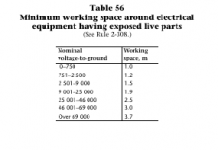2-308 Working space around electrical equipment
(1) A minimum working space of 1 m with secure footing shall be provided and maintained about electrical
equipment such as switchboards, panelboards, control panels, and motor control centres that are enclosed
in metal, except that working space is not required behind such equipment where there are no renewable
parts such as fuses or switches on the back and where all connections are accessible from locations other
than the back.
(2) The space referred to in Subrule (1) shall be in addition to the space required for the operation of draw-
out-type equipment in either the connected, test, or fully disconnected position and shall be sufficient for
the opening of enclosure doors and hinged panels to at least 90°.
(3) Working space with secure footing not less than that specified in Table 56 shall be provided and maintained
around electrical equipment such as switchboards, control panels, and motor control centres having
exposed live parts.
(4) The minimum headroom of working spaces around switchboards or motor control centres where bare live
parts are exposed at any time shall be 2.2 m.
2-310 Entrance to, and exit from, working space (see Appendices B, G, and I)
(1) Each room containing electrical equipment and each working space around equipment shall have
unobstructed means of egress in compliance with the National Building Code of Canada.
(2) Where a room or space referred to in Subrule (1) contains equipment that has a rating on the equipment
nameplate of 1200 A or more, or is rated over 750 V, and consists of transformers, overcurrent devices,
switchgear, or disconnecting means, such equipment shall be arranged so that, in the event of a failure in
the equipment, it shall be possible to leave the room or space referred to in Subrule (1) without passing
the failure point, except that where this cannot be done, the working space requirement of Rule 2-308(1)
and (2) shall be not less than 1.5 m.
(3) For the purposes of Subrule (2), the potential failure point is any point within or on the equipment.
(4) Doors or gates shall be capable of being readily opened from the equipment side without the use of a key
or tool.

